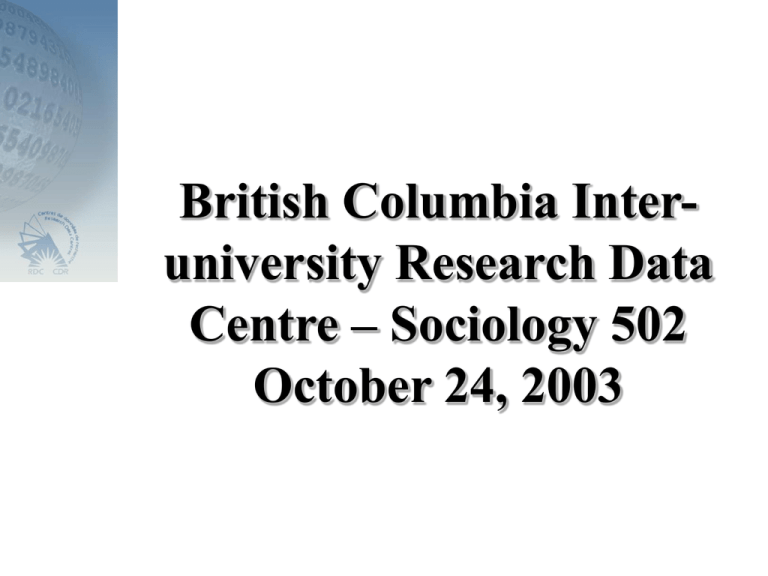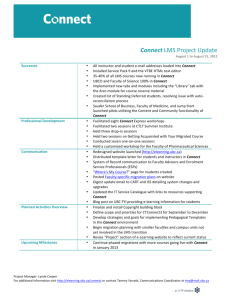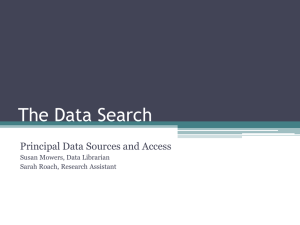BCIURDataCentre
advertisement

British Columbia Interuniversity Research Data Centre – Sociology 502 October 24, 2003 Access to Statistics Canada data • Public use cross-sectional microdata files are available through the UBC Data Services website http://data.library.ubc.ca. Offers easy access to less detailed cross-sectional data. • Mary Luebbe is the Data Services librarian at mluebbe@interchange.ubc.ca. • Detailed longitudinal and cross-sectional microdata are available at the Research Data Centre • Census, CANSIM and E-Stat offer extensive aggregate data series accessible through http://data.library.ubc.ca and http://www.statcan.ca. Canadian Initiative on Social Statistics The CISS is a joint initiative of Statistics Canada and SSHRC with two main components: • Research Data Centres Program • Data Training Schools Program What is a Research Data Centre? Houses detailed confidential microdata and documentation files from Statistics Canada Computer laboratory with an extensive selection of analytic software Physically secure facility with no network connections outside the centre. Access limited to researchers with approved projects, reliability security status, and “sworn-in” under the Statistics Act as “deemed employees” of Statistics Canada. Staffed by a Statistics Canada analyst Analytic results are checked before leaving the RDC to ensure respondent confidentiality is protected Mission of the RDCs • To promote and facilitate quantitative research on the economy, education, health and society that will benefit all Canadians and enhance Canada’s standing in the global community. • To provide secure access to Statistics Canada household and workplace survey microdata to researchers in regions across Canada. • To visibly protect the confidentiality of respondents of Statistics Canada surveys. • To disseminate research findings to the policy community and to the public on a wide range of economic, human developmental, health and social issues. RDC locations University of Alberta University of British Columbia University of Calgary University of Toronto McMaster University Waterloo University UNB Université de Montréal Dalhousie Data Training Schools • Competitive process managed by SSHRC • Instruction on advanced analytical techniques - focus on longitudinal analysis • Each year SSHRC and Statistics Canada support several DTS programs at universities • Example: SPIDA at York University http://www.yorku.ca/spida Longitudinal data holdings New longitudinal surveys for which it is not possible to produce public use longitudinal microdata files: • Longitudinal Survey of Immigrants to Canada (available in 2003) (LSIC) • National Longitudinal Survey of Children and Youth (NLSCY) • National Population Health Survey (NPHS) • Survey of Labour and Income Dynamics (SLID) • Workplace and Employee Survey (WES) • Youth in Transition Survey (YITS) Cross sectional data holdings • • • • • • • • • • • Canadian Community Health Survey (CCHS) Health Services Access Survey (HSAS) Ethnic Diversity Survey (release winter 2003) Food Expenditure Survey (FoodEx) General Social Survey (selected cycles) Labour Force Survey (LFS) Employment Insurance Coverage Survey (EICS) Survey of Consumer Finances Survey of Financial Security (SFS) Programme for Int’l Student Assessment (PISA) Survey of Approaches to Educational Planning (SAEP) • Surveys of Graduates and Follow-up Surveys of Graduates (SOG and FSOG) • Survey of School Leavers • Adult Education and Training Survey • and other household surveys Current BCIRDC projects • • • • • • • Children, youth and families Public Policy and Child Care Family environment and child outcomes Resilience and hope among rural adolescents Adolescent risk-taking behaviour Vulnerable teens Consequences of union disruption for women and children Parental labour supply, child care and child outcomes Education • Determinants of parents’ planning for their children’s post-secondary education • Equity of university attendance in Canada: have tuition increases had an impact? • Social interactions and schooling • Choice of field of study and graduate outcomes Health • Conventional and complementary therapies used by older adults with arthritis • Psycho-social causes of chronic pain • Health, income and employment • Population-clinical simulation model of osteoarthritis development and applications • Immigrant status and unmet health care needs in British Columbia • Assessing mental health: what are we measuring and how does it relate to health-care utilization? • Unemployment and health Income, spending and wealth • Pay equity • Evolution of the earnings structure since the 1960’s • Food policy effects on nutrient consumption among low-income households • Taxation, savings and portfolio allocations • Participation and savings in RESPs Labour • Movements in job tenure of new labour market entrants • Job tenure and firm size • High school completion/leaving and repeat use of Employment Insurance • EI benefits, job search and labour force participation • EI affects on job tenure • Fertility and female labour supply • Nursing labour market • Factors affecting entrepreneurial success of immigrants in Canada • Changes in job stability since 1976: a cohort explanation Workplace practices and policies • Employment standards legislation and employment and hours variations • High performance work practices, workplace performance, downsizing and employee well-being • Strategic focus and performance • Impact of combinative capabilities on small firms’ performance • Competitive policies and firm performance • Determinants of hours constraints Who uses the RDCs? SFU, UBC and UVic graduate students and faculty from many diverse disciplines: • Agricultural sciences • Business and Public Administration • Counselling and Educational Psychology • Economics • Family Studies • Gerontology • Health care and epidemiology • Nursing • Sociology • and other disciplines What scale of research is best suited for the RDCs? Longer term projects are best suited for the RDCs • graduate thesis/dissertation research • individual research projects for journal manuscripts, conferences or policy papers • team projects involving faculty and students working at one or several RDCs Public-use data is better suited for course studies and other short term projects. Support for researchers using the BCIRDC • Statistics Canada analyst on site to provide support • Off-site syntax development – Dummy/synthetic data is available for the NLSCY, NPHS and WES (with remote access). Allows researchers to prepare their syntax before coming to the BCIRDC. • Methodological – Access to methodological support through Statistics Canada. Access to the RDCs • Project proposal submitted to SSHRC through an online application system. Links to the application site are on BCIRDC website at: http://data.library.ubc.ca/rdc/ on the Application Process page. • Proposal evaluation by SSHRC peer review and Statistics Canada – Is access to confidential microdata necessary? – Will the data support the analysis? – Does the project have scientific merit? – Does (do) the researcher(s) have the expertise to conduct this research? Access to the Research Data Centres (cont’d) • Proposal must be made for specific project • Security check - enhanced reliability status • Orientation session and “oath of office” • Researcher agrees to provide publicly available report that falls within Statistics Canada’s mandate RDC products • Research paper series available from RDC web sites summaries and links on the Statistics Canada site •Websites •BCIRDC at http://data.library.ubc.ca/rdc/ •Statistics Canada at www.statcan.ca/english/rdc/ •BCIRDC newsletter •BCIRDC seminars and workshops •RDC conferences to connect researchers and policy makers




![July 31 Connect eupdate DRAFT [1]](http://s3.studylib.net/store/data/008100166_1-21bd0e395dcbfd67aaad5f18dd4ec08e-300x300.png)





